Bengal War
Bengal War,[2] Campaign for the Eastern Subah's, was waged by the Mughal imperial crown Prince Ali Gohar later known as Shah Alam II so as to recapture the Nawab of Bengal from the British East India Company, hostilities began in 1756 and ended in 1765.
| Bengal War | |||||
|---|---|---|---|---|---|
| |||||
| Belligerents | |||||
|
| ||||
| Commanders and leaders | |||||
|
| |||||
Background
The English East India Company captured the territories of the Nawab of Bengal during the Seven Years' War and refused to pay taxation and tribute to the Great Moghul.
This annexation caused Shah Alam II to wage the Bengal War in 1759.
Although the Battle of Patna (1758), Battle of Chinsurah (1758) and Battle of Fort St. David (1758) were already fought.
Campaign
Shah Alam II was joined by Mir Qasim and most of the battles of the Bengal War took place around the city of Patna whose leaders Ramnarian was an ally of the East India Company was defeated in 1759.
In 1760 Shah Alam II was routed by John Caillaud, and Miran (son of Mir Jafar).
In 1761 Shah Alam II was also joined by the Rohillas, Durrani's and the Nawab Vizier (Grand Vizier) Shuja-ud-Daula whom had been a belligerent in the victory against the Maratha Confederacy at the Third Battle of Panipat.
Together they marched towards Murshidabad; compelled again to retreat in defeat. They then besieged Patna, but was beaten off by Capt. Knox’s force.
Shah Alam II was taken prisoner by Major Camac, 1761, in Bihar; and allowed to retire to Awadh where he was crowned emperor again.
From there he planned further expeditions against Bengal Subah with the help of Nawab Shuja-ud-Daula.
But perhaps his most formidable subject during the Bengal War was Mir Qasim.
Together they formed a coalition led by the Great Moghul himself at the Battle of Buxar against the East India Company's Hector Munro of Novar.
Shah Alam II, whom would later become a pensioner of the British East India Company in 1765.
Aftermath
Shah Alam II did manage to capture and hold Bihar before becoming a pensioner of the English.
John Caillaud had set three official seals to document expressing an intent to kill Shah Alam II, while he had the Mughal Crown Prince, allegations that Caillaud would later strongly deny.[3]
The English East India Company waged a campaign to overthrow Shuja-ud-Daula.
Gallery
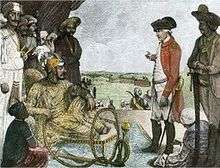 The Mughal Emperor Shah Alam II, as a prisoner of the British East India Company, 1781
The Mughal Emperor Shah Alam II, as a prisoner of the British East India Company, 1781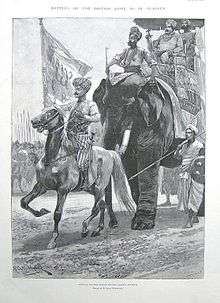 The Nawab of Bengal, Mir Qasim
The Nawab of Bengal, Mir Qasim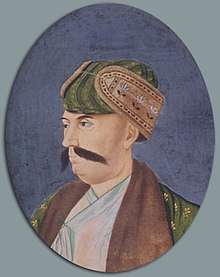 Shuja-ud-Daula served as the leading Nawab Vizier of the Mughal Empire, he was a lifelong of Shah Alam II.
Shuja-ud-Daula served as the leading Nawab Vizier of the Mughal Empire, he was a lifelong of Shah Alam II.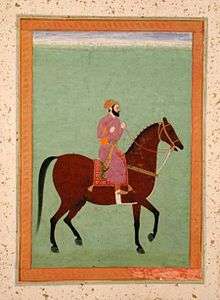 Mirza Najaf Khan Baloch, the commander-in-chief of the Mughal Army.
Mirza Najaf Khan Baloch, the commander-in-chief of the Mughal Army. Political map of the Indian Subcontinent in the year 1765.
Political map of the Indian Subcontinent in the year 1765._and_Mir_Miran_(right).jpg) Mir Jafar and his son Mir Miran.
Mir Jafar and his son Mir Miran.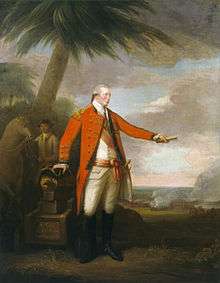 Sir Hector Munro of Novar.
Sir Hector Munro of Novar.
References
- History of the Freedom Movement in India (1857–1947), p. 2, at Google Books
- Jaques, Tony (2007). Dictionary of Battles and Sieges: F-O. ISBN 9780313335389.
- John Caillaud at Oxford Dictionary of National Biography